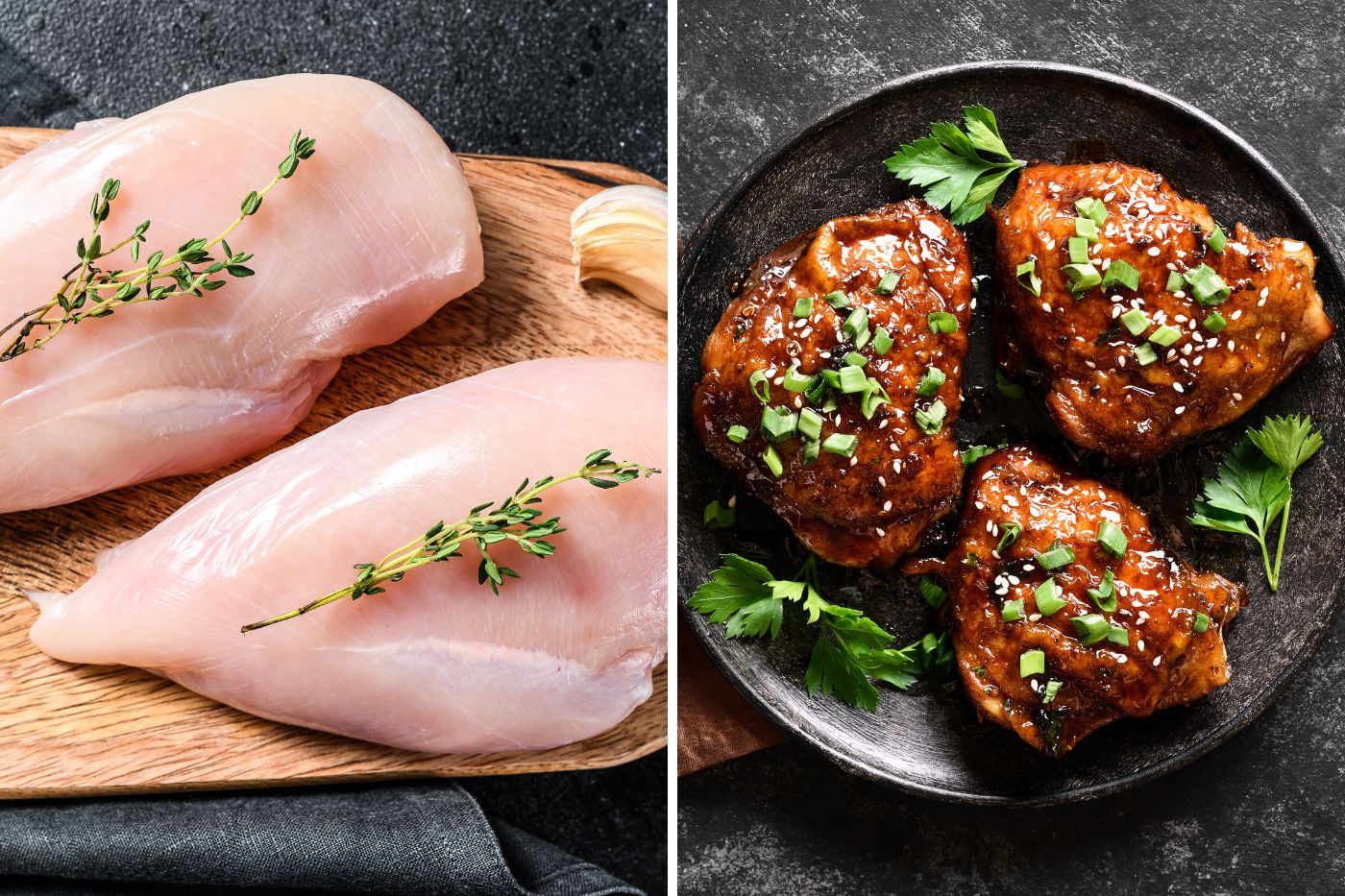Chicken Breast vs. Chicken Thighs (Which Packs More Flavor Punch?)
Chicken breast vs. chicken thighs are two popular chicken cuts. Discerning palates passionately argue over which succulent preparation unleashes the most exquisite, mouthwatering flavors. Flavor is essential when choosing what to eat.
This delectable analysis will thoroughly explore and savor the rich, robust flavors that juicy chicken breasts and succulent chicken thighs bring to the table. The goal is to decide which cut has more flavor.
The Case for Chicken Breast

Chicken breast is a lean and versatile cut. It is the white meat from the breast portion of the chicken. Chicken breasts tend to have a mild flavor on their own.
Because chicken breast is low in fat, it is considered lean meat. This makes it a popular choice for people watching their fat intake. The leanness also allows the natural chicken flavor to shine through.
Chicken breasts are well-suited for many cooking methods. They can be grilled, baked, sautéed, or cooked in other ways. No matter how they are prepared, chicken breasts tend to remain moist and tender when cooked properly.
One advantage of chicken breast is its ability to take on flavors from marinades, rubs, and sauces. Since it initially has a relatively mild taste, it easily absorbs flavors from herbs, spices, and other ingredients. This allows cooks to create endless flavor variations with chicken breasts.
The Case for Chicken Thighs

Chicken thighs are the darker meat from the top portion of the chicken’s leg. They have a richer, more robust flavor than chicken breasts.
One major advantage of chicken thighs is their juiciness and tenderness. Thighs are higher in fat compared to breasts, which keeps the meat moist and succulent when cooked properly. The extra fat also makes them more forgiving if overcooked slightly.
Chicken thighs lend themselves well to cooking methods like roasting, braising, and frying. The higher fat content allows the skin to crisp up beautifully when roasted. Braising helps the thighs become extremely tender while soaking up flavors from the braising liquid.
The higher fat and myoglobin content in thigh meat directly contributes to its stronger, more savory flavor. The fats carry and enhance the chicken’s natural flavors. This makes chicken thighs inherently more flavorful than the leaner breasts without added ingredients.
Flavor Comparison
When it comes to a direct flavor comparison, chicken thighs have a clear advantage over chicken breasts in terms of depth and richness of flavor.
Chicken breasts on their own have a mild, delicate flavor. When expertly prepared, their lean composition allows the natural flavors to shine through with a delightfully moist and savory essence, but any overcooking can, unfortunately, strip away that delicate tastiness, leaving an unappetizingly dry and bland result. However, breasts make an excellent canvas for other flavors from marinades, rubs, and sauces.
In contrast, chicken thighs possess an inherent robust, savory flavor even without added seasonings. Their higher fat content keeps the meat juicy and tender. The fats also carry the chicken’s natural flavors, amplifying the rich poultry taste.
When it comes to texture, thighs have a more succulent, melt-in-your-mouth quality due to their higher fat levels. Properly cooked breasts retain a succulent tenderness and juicy richness, while even slight overcooking can render them unappetizingly stringy and undesirably dry.
Cooking methods play a role too. Thighs shine when roasted or braised, allowing the fats to render and the meat to become fall-off-the-bone tender. Breasts do well with faster, drier cooking like grilling or baking to prevent dryness.
While both cuts take on flavors from marinades and seasonings, chicken thighs tend to have a more pronounced chicken flavor that comes through no matter what.
Nutritional Comparison
From a nutritional standpoint, some notable differences between chicken breasts and chicken thighs are worth considering.
Chicken breasts are significantly lower in fat and higher in protein compared to thighs. A 3.5 oz (100g) serving of skinless chicken breast contains around 165 calories, 31g of protein, and only 3.6g of fat.
The same serving size of chicken thighs with the skin on provides around 209 calories, 26g of protein, but a much higher 13g of fat.
The lower fat content of chicken breasts makes them a better choice for those watching their fat and calorie intake or following a leaner diet plan. The higher protein in breasts is also beneficial for muscle growth and repair.
However, the higher fat levels in chicken thighs are not necessarily bad from a nutritional view. The fats provide energy, facilitate nutrient absorption, and add flavor satisfaction which can prevent overeating.
For those with an active lifestyle or looking to increase healthy fats, chicken thighs can be a good option as part of a balanced diet, though the skin should be removed to reduce saturated fat intake.
Ultimately, the nutritional choice comes down to personal dietary goals, preferences, and how the two cuts fit into one’s overall eating pattern.
Culinary Versatility
Both chicken breasts and chicken thighs offer excellent versatility in the kitchen, allowing them to be used in a wide range of recipes and cuisines. However, each cut tends to shine in certain types of dishes.
Chicken breasts, with their lean and tender texture, excel in preparations where they can remain moist and take on flavors well. Some great examples include:
- Grilled chicken salads and wraps
- Chicken pasta dishes like chicken alfredo or chicken parmesan
- Chicken stir-fries and fajitas
- Baked chicken dishes smothered in sauces or topped with breadcrumbs
On the other hand, chicken thighs are better suited for recipes where they can become delightfully tender and their rich flavor can be showcased, such as:
- Hearty chicken stews and curries
- Braised chicken dishes like chicken cacciatore
- Roasted chicken thighs with crispy skin
- Southern-style fried chicken
- Chicken rice dishes like chicken biryani
The added fat in thighs allows them to stay succulent through the long cooking times required for stews, braises, and roasts. Their robust flavor also stands up well to bold spices and aromatics.
That said, chicken breasts and thighs can often be used interchangeably in many recipes, with some adjustments for cooking times and techniques. The choice comes down to personal taste preferences, nutritional needs, and the desired flavor profile for the dish.
Personal Preferences and Cooking Tips
At the end of the day, the choice between chicken breast and chicken thighs often comes down to personal taste preferences. Some people favor the milder flavor and leaner profile of chicken breasts, while others crave the richer, more robust taste of chicken thighs.
For those who enjoy the simplicity of chicken breast, a few cooking tips can help maximize its flavor:
- Brine or marinate the chicken to keep it moist and infuse flavor
- Cook chicken breasts with the skin on to retain moisture
- Don’t overcook – use a meat thermometer to ensure juicy results
- Top with flavorful sauces, pestos, or chutneys after cooking
Chicken thigh lovers can employ these techniques to unlock the cut’s full flavor potential:
- Render the fat and get the skin crispy by roasting or searing thighs first
- Braise thighs in flavorful liquids like wine, stock, or spice-infused sauces
- Add aromatics like garlic, onions, and herbs while cooking
- Finish thighs on the grill for a lovely char flavor
The beauty is that both cuts are incredibly versatile canvases for flavors. Don’t be afraid to experiment with different marinades, rubs, cooking methods, and flavor pairings for each cut. Tasting is the best way to discover your personal preferences.
Final Thoughts on Chicken breast vs. chicken thighs
Exploring the flavors of chicken breast and chicken thighs reminds us of the sheer joy that can be found in cooking with such a versatile ingredient. Chicken, in all its forms, offers endless possibilities for culinary creativity and flavor adventures.
Whether you favor the delicate charm of chicken breasts or the rich indulgence of chicken thighs, the act of preparing and savoring these dishes connects us to a timeless tradition of nurturing ourselves and others through food.
As you continue your culinary journey, I encourage you to embrace both of these beloved cuts of chicken, experimenting with different techniques, seasonings, and flavor combinations until you find the perfect match for your taste buds.
And perhaps most importantly, I invite you to share your own experiences, tips, and preferences in the comments below. After all, the true essence of good food lies in the stories and memories we create together around the table.
So, let’s raise a fork (or a drumstick!) to the humble chicken, and to the countless flavor-filled adventures that await us in the kitchen.
Additional Resources
For those looking to deepen their knowledge and explore more recipes featuring chicken breasts and thighs, here are some helpful additional resources:
Cooking Guides:
How to Cook Moist Chicken Breasts Every Time
5 Uses for Washi Tape in the Kitchen
I hope these resources prove useful in your ongoing chicken flavor journey! Feel free to share any standout recipes or tips you discover.








